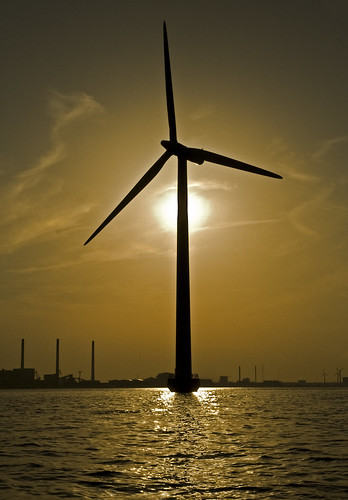This great shot by Denis Collette; a great artist & member on www.flickr.com
Friday, August 31, 2007
Watercourse! / Voie d’eau!
Thursday, August 23, 2007
Windmill
Wind energy is applicable in those windy region, the technology is very stable.
I just wonder why countries are not promoting on this.
This great shot by Martini DK, a great artist & member on www.flickr.com
Sunday, August 19, 2007
Monday, August 13, 2007
http://newsletters.businessweek.com/c.asp?669160&012b306f8bdc8158&20
This is an issue that I advocating for long. Corporate Senior Executives have not been seeing the important of it. I hope they would see these now!!
@@@@@@@@@@@@@@@@@@@@@@@@@@@@@@@@@@@@@@@@@@@@@@@@@@@@@@@@@
How To Heal A Sick Office
From replacing synthetic materials to letting the sun shine in, cleaning up a toxic workplace is easier than you think
Ever since cubicles sprouted up in office buildings 40 years ago, inhabitants have been under assault. Chemicals in carpet glue, cleaning supplies, and printer cartridges can cause headaches, dizziness, lethargy, rashes, nausea, and respiratory irritation. This could be solved by pumping in lots of fresh air, but the windows in most modern office buildings are sealed shut. Then there's the space allocation: A typical office worker gets about 40 sq. ft.—less than a third as much as in the 1970s. Dozens of studies have documented the toll all this takes on body and mind. How are we ever going to blossom into globally networked, branded superstars while trapped in shrinking cubicle farms bathed in foul fumes?
The fix may be simpler than you think. Healing sick offices is generally a matter of replacing synthetic materials with natural alternatives, improving the flow of fresh air, and letting some natural light shine in. Healthy options—including clever techniques for pumping sunlight deep into a building's recesses—are proliferating. And while it's hard right now to know which microscopic evils may be lurking in your cubicle, the next decade will bring cheap consumer tests for airborne toxins and pathogens. Scientists are also working on newfangled materials to mix into coatings that can suck toxins out of the air.
But don't wait for these magic developments. Managers who start cleaning and brightening up their employees' workspaces right away can expect to be rewarded with lower costs, fewer incidents of illness and absenteeism, higher productivity, and the recruitment of better-qualified staff. A 2003 study of call centers found that workers with window views processed calls 6% to 12% faster, performed up to 25% better on mental acuity tests, and reported fewer health problems than their peers in conventionally lit spaces.
Businesses that do right by cubicle-dwellers may also find that they're doing good for the environment. That will bring benefits down the road. Letting in more natural light cuts a company's energy consumption, and that matters to earth-conscious job seekers. In a study by office goods supplier Corporate Express, 64% of workers—from the mail room to the executive suite—said their decision to work for a company is guided in part by its green practices.
Here are some of the things that sap health and morale in the workspace, and ways to make them better.
Friday, August 10, 2007
Tuesday, August 07, 2007
Stanwell Power station
This Coal fired Power Plant, are the main electric power resourceses for Power hungry China.
When the Developed Countries export the manufacturing base to China.
The Industries Waste such as these are also exported.
The Coal industry in Wales once was shut down in the 70's & 80's, but I believed that now China is buying Coal from Country like Wales; Australia..etc.
In my discussion with the authority concern, I am advocating alternative energy such as Solar; Wind & Geo Thermal or Bio-Waste for electric city generations.
However, it is difficult for them to accept the facts that that is best solution.
As for the balance of trade between provinces & also the balance of trade between countries internationally. For Economic reason & financial gain for both end & in private, trading of coal & fossil fuel have created many millionaires.
What can I do for now is just to express my opinion here for all to think about!!
This great shot by d70dug I will not pay to support censorship!
A great artist & member on www.flickr.com
Friday, August 03, 2007
Populations & Pollutions

Environmental group-Children 'bad for planet'!! "If couples had two children instead of three they could cut their family's carbon dioxide output by the equivalent of 620 return flights a year between London and New York. ", originally uploaded by NICE JEWISH GIRL.
The following report is adapted from Gail Orenstein.
In my opinion, I do agreed with Prof. John Guillebaud, In addition to that, the human wastes; plus the human manufactured wastes are added to the cause of green house effect.
The other issue that contributing to the Global warming are the Houses that built re 2nd war world till 1990. The technology have not been use to maintain a constant temperature, is use fossil fuel; coal energy to warm up or cool down the home or building.
Please read the following for more.....
@@@@@@@@@@@@@@@@@@@@@@@@@@@@@@@@
Environmental group-Children 'bad for planet'!! "If couples had two children instead of three they could cut their family's carbon dioxide output by the equivalent of 620 return flights a year between London and New York. "
Photo-Gail orenstein.
Gail Orenstein Diary Blog
Gail Orenstein's GoPhotos Blog
Production Robert Hooker
HAVING large families should be frowned upon as an environmental misdemeanour in the same way as frequent long-haul flights, driving a big car and failing to reuse plastic bags, says a report to be published today by a green think tank.
The paper by the Optimum Population Trust will say that if couples had two children instead of three they could cut their family's carbon dioxide output by the equivalent of 620 return flights a year between London and New York.
Full coverage: Climate change in-depth
John Guillebaud, co-chairman of OPT and emeritus professor of family planning at University College London, said: "The effect on the planet of having one child less is an order of magnitude greater than all these other things we might do, such as switching off lights.
"The greatest thing anyone in Britain could do to help the future of the planet would be to have one less child."
In his latest comments, the academic says that when couples are planning a family they should be encouraged to think about the environmental consequences.
"The decision to have children should be seen as a very big one and one that should take the environment into account," he added.
Professor Guillebaud says that, as a general guideline, couples should produce no more than two offspring.
The world's population is expected to increase by 2.5 billion to 9.2 billion by 2050. Almost all the growth will take place in developing countries.
The population of developed nations is expected to remain unchanged and would have declined but for migration.
The British fertility rate is 1.7. The EU average is 1.5. Despite this, Professor Guillebaud says rich countries should be the most concerned about family size as their children have higher per capita carbon dioxide emissions.
Source; www.news.com.au/story/0,23599,21684156-5009760,00.html
Uploaded by NICE JEWISH GIRL on 6 May 07, 11.58PM PDT.
spacer image
Compose your blog entry
Title:
Your Post:
italicboldquotelink






